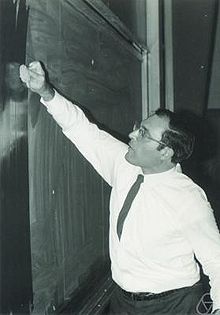Gian-Carlo Rota
Gian-Carlo Rota | |
|---|---|
 Rota in 1970. | |
| Born | April 27, 1932 |
| Died | April 18, 1999 (aged 66) |
| Alma mater | Princeton University Yale University |
| Scientific career | |
| Fields | Mathematics, Philosophy |
| Institutions | Massachusetts Institute of Technology Los Alamos National Laboratory |
| Doctoral advisor | Jacob T. Schwartz |
| Notable students | Mark Haiman, Qaiser Mushtaq, Patrick O'Neil, Richard P. Stanley |
Gian-Carlo Rota (April 27, 1932 – April 18, 1999, known as Juan Carlos Rota to Spanish-speakers) was an Italian-born American mathematician and philosopher.
Life
He was born in Vigevano, Italy, where he lived until he was 13 years old. At that time his family left Italy, initially going to Switzerland.
He attended the Colegio Americano de Quito in Ecuador, and earned degrees at Princeton University and Yale University. For most of his career he was a professor at the Massachusetts Institute of Technology, where he was the only person ever to be appointed Professor of Applied Mathematics and Philosophy. He was also the Norbert Wiener Professor of Applied Mathematics.
Rota was one of the most respected and popular teachers at MIT. He taught a difficult but very popular course in probability, 18.313, which MIT has not offered again. He also taught 18.001 (Applications of Calculus), 18.03 differential equations, and 18.315 combinatorial theory. His philosophy course in phenomenology was offered on Friday nights to keep the enrollment manageable. Among his many eccentricities, he would not teach without a can of Coca-Cola, and handed out prizes ranging from Hershey bars to pocket knives to students who asked questions in class or did well on tests.[1][2]
From 1966 until his death he was a consultant at Los Alamos National Laboratory, frequently visiting to lecture, discuss, and collaborate, notably with his friend Stan Ulam.
He began his career as a functional analyst, but changed directions and became a distinguished combinatorialist. His series of ten papers on "Foundations of Combinatorics" in the 1960s is credited with making it a respectable branch of modern mathematics. He said that the one combinatorial idea he would like to be remembered for is the correspondence between combinatorial problems and problems of the location of the zeroes of polynomials.[3] He worked on the theory of incidence algebras (which generalize the 19th-century theory of Möbius inversion) and popularized their study among combinatorialists, set the umbral calculus on a rigorous foundation, unified the theory of Sheffer sequences and polynomial sequences of binomial type, and worked on fundamental problems in probability theory. His philosophical work was largely in the phenomenology of Edmund Husserl.
He died in his sleep and was found dead in his night clothes, after failing to arrive in Philadelphia for lectures he had planned to give on April 19, 1999.[4]
A reading room (2-285) in the Department of Mathematics at the Massachusetts Institute of Technology is dedicated in his name.
See also
- Rota–Baxter algebra
- List of American philosophers
- Joint spectral radius, introduced by Rota in the early 1960s
Notes
- ^ Wesley T. Chan (December 5, 1997). "To Teach or Not To Teach: Professors Might Try a New Approach to Classes – Caring about Teaching". The Tech. Vol. 117, no. 63. Retrieved 2008-02-10.
- ^ "Gian-Carlo Rota". The Tech. Vol. 119, no. 21. April 23, 1999. Retrieved 2008-02-10.
- ^ Mathematics, Philosophy, and Artificial Intelligence: a dialogue with Gian-Carlo Rota and David Sharp
- ^ "MIT professor Gian-Carlo Rota, mathematician and philosopher, is dead at 66". April 22, 1999.
External links
- Gian-Carlo Rota at the Mathematics Genealogy Project
- O'Connor, John J.; Robertson, Edmund F., "Gian-Carlo Rota", MacTutor History of Mathematics Archive, University of St Andrews
- Kung, Joseph; Rota, Gian-Carlo; Yan, Catherine (2009). Combinatorics: The Rota Way. Cambridge Mathematical Library. Cambridge University Press. ISBN 052173794X.
{{cite book}}: External link in|title= - The Forbidden City of Gian-Carlo Rota (a memorial site) This page at www.rota.org was not originally intended to be a memorial web site, but was created by Rota himself with the assistance of his friend Bill Chen in January 1999 while Rota was visiting Los Alamos National Laboratory.
- Mathematics, Philosophy, and Artificial Intelligence: a dialogue with Gian-Carlo Rota and David Sharp
- "Fine Hall in its golden age: Remembrances of Princeton in the early fifties" by Gian-Carlo Rota.
- Tribute page by Prof. Catherine Yan (Texas A&M University), a former student of Rota
- Scanned copy of Gian-Carlo Rota's and Kenneth Baclawski's Introduction to Probability and Random Processes manuscript in its 1979 version.
- Gian-Carlo Rota (1996), Indiscrete Thoughts, Birkhäuser Boston, ISBN 0817638660, ISBN 0-8176-3866-0; review at MAA.org
- The Digital Footprint of Gian-Carlo Rota: International Conference in memory of Gian-Carlo Rota, organized by the University of Milan (Italy)
- 1932 births
- 1999 deaths
- People from Vigevano
- 20th-century mathematicians
- 20th-century Italian philosophers
- American mathematicians
- American philosophers
- Combinatorialists
- Italian mathematicians
- American people of Italian descent
- Princeton University alumni
- Yale University alumni
- Massachusetts Institute of Technology faculty
- Phenomenologists
